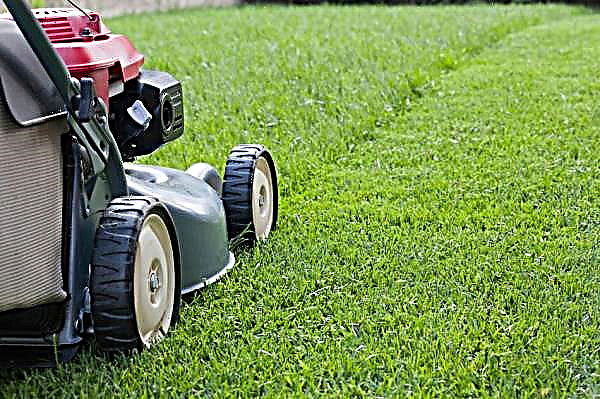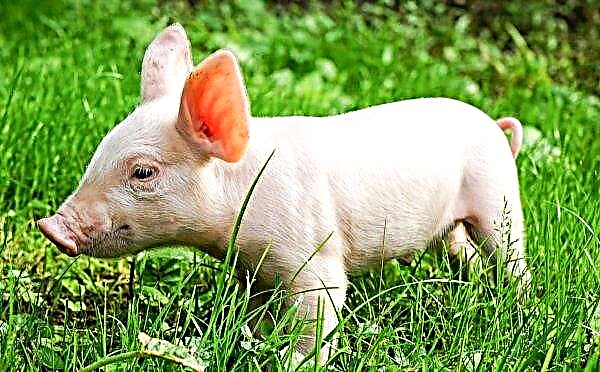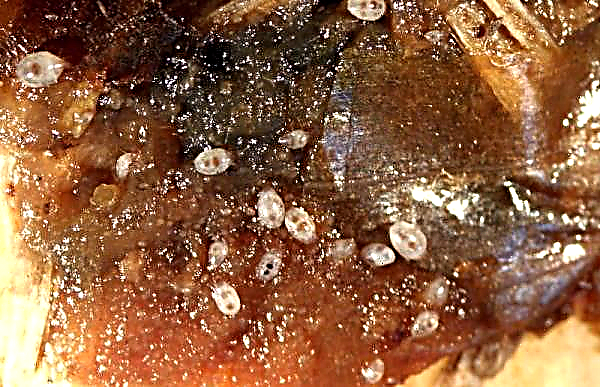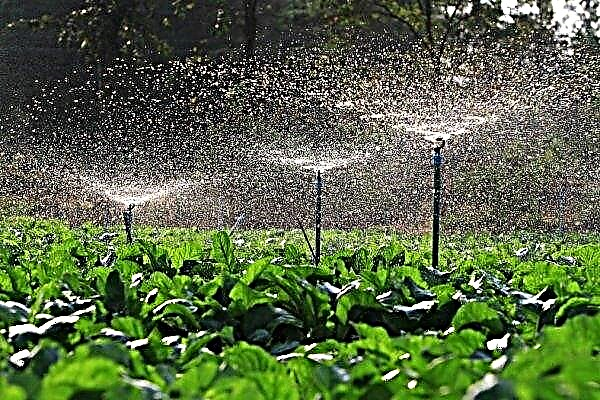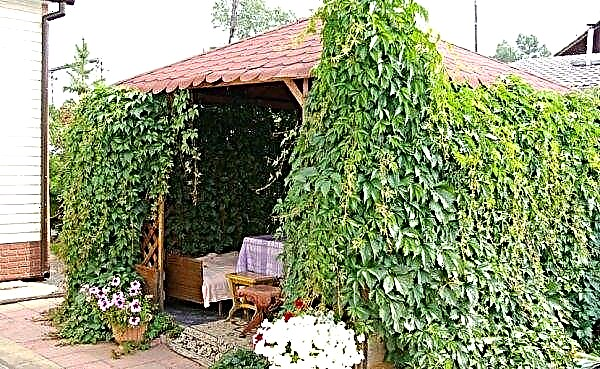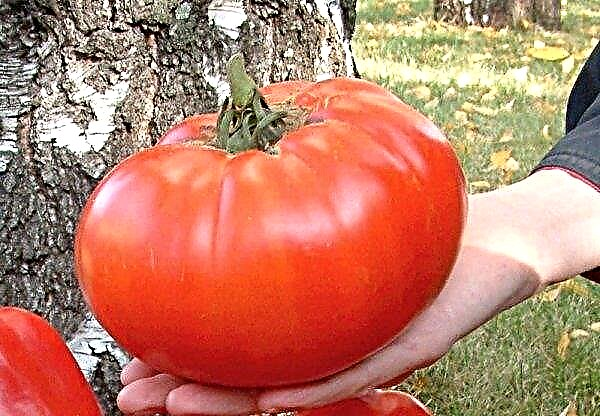Red begonia is considered one of the most amazing flowers, which is able not only to decorate squares and parks, but also to transform the home interior. The plant is simple and undemanding to care for, so both experienced gardeners and beginners will like it. Find out what are the features of the described flower and how to propagate it in a home environment.
Description and characteristics of the plant
Red begonia is a perennial decorative-flowering tuberous plant of the Begoniaceae family, a feature of which are beautiful, large flowers of saturated red color. The flowers of the crop, with a diameter of about 10 cm, consist of very delicate, slightly corrugated petals. The fragrance is delicate and sweet.
Did you know? The asteroid (943) Begonia, discovered in 1920, is named after the begonia plant.
At home, begonia can reach a height of 20–40 cm. The leaves of a houseplant are fragile, patterned, dark green in color, harmoniously combined with large, voluminous flowers. Flowering of the culture lasts several months, starting in May and ending in October, while the flowering of each peduncle is 2-3 weeks. The root system is presented in the form of medium-sized tubers and thin root processes extending from them.
Landing Features
Despite its delicate and fragile appearance, red begonia has high vitality and can be reborn even from a small piece of leaf. Landing technology is not particularly difficult, but requires accuracy and compliance with certain subtleties.
Optimal season
Planting a plant should be carried out in such cases:
- After purchase in the store. Experienced flower growers advise moving the plant to a new container with new soil immediately after purchasing it in the flower market. The fact is that in store conditions the flower is grown in special soils that are not suitable for home cultivation of begonias.
- With a strong growth of the root system. When the root roots begin to stick out of the tank, the culture should be transplanted into a new, more spacious pot, otherwise it will slow down in growth and drop flowers.
Planting begonias is best done in the spring, after it has completely faded.
Important! A flower transplant after purchase can be carried out at any time, regardless of seasonality.
Pot selection and soil preparation
When planting begonias, it is extremely important to take care of choosing the right pot. Since the root system of the flower does not differ in strong and powerful development, experts advise choosing a not very deep and wide capacity. So that the roots of the culture do not rot, and the moisture does not stagnate in the container, you need to take a small container, approximately 14 cm in diameter. With a subsequent flower transplant, you should choose a pot 1-2 cm larger than the old one. The material of the container does not matter much, but it is better to give preference to containers made of ceramic, glass or plastic.
As for the soil mixture, loose, fibrous soils are ideal for begonias, which can be purchased at flower shops or made by yourself.
For the latter option, you must mix:
- sheet earth - 2 parts;
- peat - 1 part;
- chernozem - 1 part;
- rotted manure - 10%.
Immediately before planting the crop, the soil must be decontaminated by calcining it for 25-30 minutes in an oven at a temperature of + 180 ° C or spilling it with a weak solution of potassium permanganate.
Optimal conditions
Red begonia prefers good, bright, but diffuse lighting, and can also exist perfectly in small partial shade. Fatal to the flower are direct sunlight, exposure to which can lead to burns on the foliage.
The optimal temperature indices for begonias are considered to be + 21 ... + 23 ° C in the daytime and about + 18 ° C in the night. In winter, temperature indicators are allowed to decrease to the level of + 15 ... + 18 ° С.Due to its tropical origin, the plant loves high humidity, but it negatively refers to surface spraying. When moisture enters the foliage, brown spots form, which subsequently are converted into putrefactive areas. If the humidity level is insufficient, it is recommended to place the container with the flower in a water tray or install additional moisture sources near the flower: indoor fountains, humidifiers, fish tanks, etc.

Landing technology
Planting begonias is a fairly simple process and is based on the following actions:
- Before planting in the ground, a thorough visual inspection of the root system is carried out. All rotten, dry, damaged areas are removed, the roots are soaked for 20-40 minutes in any solution of the fungicidal preparation.
- At the bottom of the prepared container, a small layer of drainage is poured, as an expanded clay, fine pebbles. The drainage layer should occupy no more than 10% of the volume of the entire pot.
- On the drainage layer, loose soil is poured onto which a tuber is planted “on the shoulders”. When planting, it is very important not to deepen the tuber too much.
- The plant is sprinkled with soil, watered.
Important! Until the begonia is rooted, it should be watered along the edge of the pot. Also, it is impossible to expose it in the sun during the adaptation period of the plant, approximately 1 month.
Home Care
Decorative-flowering begonias are undemanding, but, nevertheless, beginning gardeners should familiarize themselves with the basic rules and subtleties of winter and summer flower care.
Top dressing
Of particular importance for begonia are regular top dressing, which it urgently needs during the period of active flowering - from April to September. During this period, it is recommended that at each watering, approximately 1 time in 10-14 days, apply liquid fertilizers specially designed for indoor decorative-flowering crops. The plant responds well to minerals or organic mixtures, for example, bird droppings or rotted manure. For the described flower variety, it is better not to abuse nitrogen-containing fertilizers, since they inhibit the development of flowers and activate the growth of greenery.
In the dormant period, which lasts from October to March, fertilizing is not worth it.
Watering
Begonia prefers moderate watering, the need for which is determined by drying the topsoil - approximately once a week. When watering a plant, do not allow excessive soil moisture, as this can provoke rotting of the root system. At the same time, it is not recommended to allow prolonged drought, since the plant can drop flowers.
In winter, when the flower is at rest, the frequency of irrigation should be reduced to once every two weeks.
Pruning
It is impossible to grow a plentifully flowering, aesthetically attractive plant without carrying out the mandatory procedure - pruning, which is required for:
- the formation of a lush crown and aesthetic form;
- rejuvenation of the bush;
- flowering improvements.
If this stage is ignored, the plant loses its decorative attractiveness, acquires a groomed appearance, the flowers become smaller, and the shoots become thinner.
The formation of the crown must be taken care of even at the stage of a young plant. When the begonia reaches a height of 6-7 cm, the top should be cut off, which will activate the development of lateral shoots. As soon as the lateral processes grow to 10 cm, it is also necessary to trim their tops. In this case, it is important to ensure that the processes are shortened above the kidney, directed to the outside.
Subsequent crop pruning is recommended systematically. To do this, shorten too long shoots, remove damaged or dry shoots, and remove dried leaves and inflorescences.
Tuberous species of begonias require mandatory pruning for the winter.
Events should be held in October:
- A few weeks before circumcision, reduce the number of moisturizers.
- After the leaves and flowers dry out, the aerial part of the culture is cut off, leaving 1-2 cm on the surface.
- After pruning, the plant is placed in a dry, cool room with stable temperature values not higher than + 15 ° С.
Transfer
When the root system of begonia grows, it is recommended to transplant it into a new pot, the diameter of which is 2-3 cm larger than the previous one.
Important! A transplant of a young plant, under the age of three years, must be done every year, in the spring. An adult flower older than 3-4 years is transplanted once every 3-4 years.
The process of plant transplantation is similar to the process of planting it. The flower must be carefully removed from the old container, thoroughly cleaned from the soil residues of the root processes, treat the roots with a solution of potassium permanganate or any fungicidal preparation. The prepared culture must be planted in a new pot and provided with proper conditions: temperature, lighting, watering.
Begonia propagation methods
In apartment conditions, several simple methods are used to breed begonias: tubers, seeds, cuttings or dividing the bush. All of them have their own characteristics.
Tuber propagation
Breeding a flower with tubers is the most simple and affordable. The tuber of the culture must be divided into two parts so that each of them receives at least one kidney.
The obtained pieces of tubers should be placed in moist peat and make sure that the soil always remains slightly moist during rooting. Sprouts are recommended to organize the temperature regime within + 9 ... + 11 ° С.
It should be noted that tuberous begonia sprouts rather slowly. In order for it to adapt faster, planting work should be carried out from February to May.
Seed propagation
Getting a new flower from begonia grains is quite simple and quick if you follow the following instructions:
- A substrate prepared from the same parts of peat and river sand of fine fraction is poured into the tank.
- The soil is moistened by means of a spray, the seeds are distributed evenly over the surface, without deepening into the soil.
- The pot of seed is covered with glass or film, placed in a well-lit, warm room.
- Crops are regularly moistened through a pallet or using a spray bottle.

When the first shoots appear, the shelter is removed. As soon as 3-4 full leaves are formed on the seedlings, they are planted in separate containers. Two months later, young sprouts are allowed to transplant into permanent pots.
Important! Obtained from begonia seeds can bloom in the first year, however, for this they need to organize additional illumination.
Sowing seeds is recommended in the last weeks of February - the first weeks of March.
Division of bushes or rhizomes
Propagation by dividing bushes or rhizomes is practiced for deciduous varieties of begonia.
In this case, flower breeding activities are carried out in the spring:
- The plant is removed from the container, residual soil is removed from the rhizome.
- The rhizome with a sharpened disinfected knife is cut into a couple of parts so that each has root processes and at least one shoot or kidney.
- All places of cuts are treated with chopped charcoal.
- The resulting parts of the rhizome are planted in separate containers filled with peat and sand.
- The container is covered with a plastic film, the seedlings are provided with regular ventilation and hydration.

Cuttings
One of the most popular methods of reproduction is considered to be cuttings, which are carried out according to this algorithm:
- On the flower, choose one strong, powerful stem, on which 1-2 buds are located.
- Sections are made under the lower and upper kidneys at a distance of 50 mm.
- If there are leaves on the handle, they are cut in half.
- Cuttings are inserted into a peat-sand substrate.
- The container is covered with plastic wrap or a bottle of plastic.
- Cuttings are ventilated every 2-3 days.
The rooting of cuttings, as a rule, takes from two weeks to one month. Moreover, in the cuttings of the same plant, the rooting rate can be completely different.
Video: Propagation of begonia by cuttings
Leaves
The described method is suitable in cases where you need to get a large amount of material for planting.
Reproduction by leaves is carried out according to this scheme:
- The plant selects the strongest and largest leaf.
- The sheet is cut into square parts, not more than 2 cm.
- Slices are placed in a soil mixture consisting of equal parts of peat and river sand.
- The container with the material is covered with a plastic film to achieve the greenhouse effect.
- After 2-3 weeks, the leaves should take root. All this time they cannot be touched and the film removed.

After three weeks, the shelter must be removed for 30 minutes and ventilate the sprouts. Every day, the airing time should be increased. Shelter may be removed and not returned after complete rooting of the leaves.
Possible growing problems
When growing red begonia, it is very important to provide her with competent care before and after planting. Otherwise, the plant may become a victim of pests or various ailments.
Did you know? In 1988, in honor of the friendship between Japan and the Korean People’s Republic, a new variety of begonia “Kimcheniria” was bred, the author of which was a famous Japanese biologist. A feature of the plant is that it blooms annually on February 16, the birthday of leader Kim Jong Il.
Diseases
Failure to comply with the regime of watering and top dressing, lack of lighting or humidity can trigger the development of various diseases in begonia.
Most often, a culture is susceptible to:
- Gray rot. The disease manifests itself in the form of white spots on the surface of leaves, buds, stems, which are later converted into putrefactive areas. Progressing, the disease leads to the fall of flowers, leaves, complete rotting of the branches. To combat the disease, the plant is treated with a solution of soapy water, Bordeaux liquid or fungicidal in-store preparations.

- Powdery Mildew. White spots appear on the culture leaves, which subsequently completely cover the leaf plate, as a result of which it darkens and dries out. For the treatment of the disease, foliage is sprayed with a solution of copper sulfate.

- Bacterial spotting. The disease described is characterized by watery spots on the underside of the leaf plate. Unfortunately, the disease is not treatable and if the foliage is damaged, the plant should be destroyed.
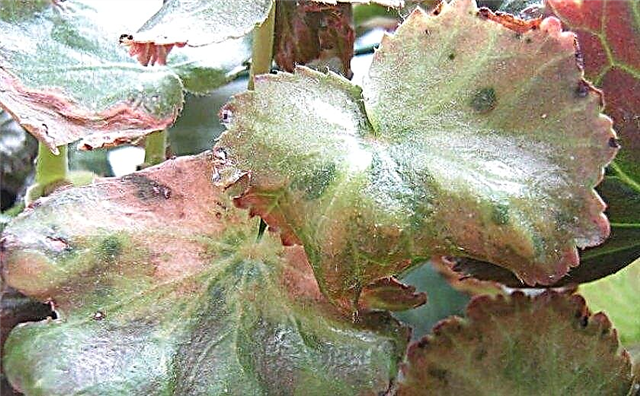
- with a lack of moisture and dry air, it discards leaves and flowers;
- with a deficit of lighting - the leaves lose their bright color, become faded;
- at reduced temperature indicators it is exposed to gray rot.
Pests
Often, a homely beauty is attacked by pests and parasites, among which the greatest danger is:
To destroy parasites, it is recommended to treat the plant with modern broad-spectrum insecticides or use folk remedies - for example, soap solution.Red begonia is considered one of the most unusual and beautiful varieties of this decorative culture. Lush, voluminous bright red flowers will appeal to even those who have little interest in indoor plants. And, despite some nuances in leaving, novice gardeners can grow the described culture on their windowsill without problems.






